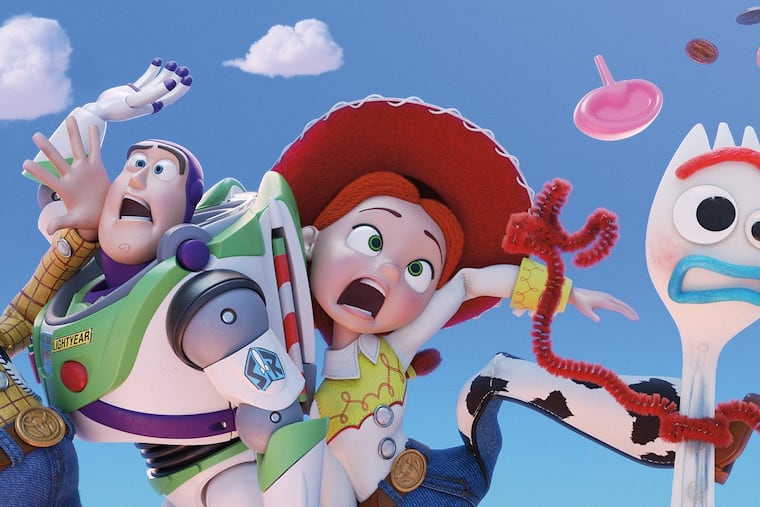‘Toy Story 4’: The best movie made about a spork | Movie review
When a child turns a spork (Tony Hale) into a toy, Woody (Tom Hanks) and the “Toy Story” gang must convince the confused object that it now has a new life.

If Pixar is getting bored with its franchise-extending chores for Disney, it certainly doesn’t show in Toy Story 4, a funny, freaky, often profound animated adventure that is certainly the best movie ever made about a spork.
You know the spork — a plastic utensil that is part spoon, part fork, and when you stand it on end, handle down, you see the vague shape of a body and head, the little fork tines suggesting the crude outline of a bad haircut.
At least that’s what occurs to poor little Bonnie on her miserable first day of kindergarten, alone and isolated at a desk, head in hands, in no mood for arts and crafts.
Bonnie is the girl who inherited the vintage toys in Toy Story 3, including sheriff Woody (voice of Tom Hanks) who sees that she is anxious. So he stows away in her backpack to monitor her first day, then finds a way to get her engaged in the task of making something from the odds and ends dumped in front of her.
Bonnie, through tears, suddenly sees the jumble of items cohere — spork for a body, a pipe cleaner the arms, Popsicle sticks for feet, a Play-Doh ring for a mouth and craft store googly eyes, all askew in a way a child might arrange them.
Forky, she calls it, and so it has life — in the internal logic of the movie’s overlapping strains of make-believe, Forky (voice of Tony Hale) acquires a consciousness when he becomes a toy. Yet he’s a just-born thing, new to the universe, baffled about why he’s no longer disposable (and instinctively trying to return to the trash), confused as to why he’s thinking and talking at all.
The job of explaining this falls to Woody, and there is poignancy to this. Woody has always been a headliner, but Bonnie has moved Woody out of her rotation of favorite toys. Now the humbled cowboy must explain to Forky that he’s not only alive, but Bonnie’s favorite — essential to her well-being.
And of course Forky is her favorite. Bonnie made him, endowed him with identity. This is an astute insight into a child’s important instinct to personify the inanimate, and also means of exploring the animator’s art and the uses of creativity — favorite Pixar subjects.
Toy Story 4 is directed by Josh Cooley, who cowrote Inside Out, Pixar’s essay on childhood sadness, and you see the same ideas at work in the arts-and-crafts sequence — Bonnie converting her feelings into an impulse to invent, creating an entity to make her feel less alone (it’s funny that this process is mediated by Hanks, who did the same thing in Castaway).
Crudely rendered Forky is a actually triumph of animation — his ungainly elements an ideal expression of his chaotic state of mind. The early scenes of Woody explaining to Forky what it means to be a toy, to be “alive” as a repository of a child’s imagination and forum for complex emotional play, are some of the best things Pixar has ever done.
Forky gradually becomes more lucid and as his understanding of the situation grows (reflected in Hale’s clever vocal work). This occurs as the movie morphs into a more conventional Pixar narrative of action, rescue, and redemption. In this case, Bonnie’s family is on a road trip, Forky gets lost, and Woody works to return him — sidetracked when he spots old flame Bo Peep (Annie Potts) in an antique store and pops in for a reunion.
This is a kicky diversion, with Pixar sticking a toe into horror — the antique shop is ruled over by a creepy antique doll (Christina Hendricks) with designs on Woody’s voice box, and a trio of Howdy Doody minions at her disposal (the use of “Midnight, The Stars and You” from The Shining has me laughing still). Getting out of this potential dead-end dungeon brings out the heroine in Bo Peep, with an assist from a stunt-riding action figure (Keanu Reeves).
It’s entertaining, but you might be wondering where Forky went, why he isn’t a bigger part of the story, and why the movie didn’t stick with its exploration of Forky as a Duchamp ready-made, an object that gains meaning when repurposed by human thought. Well, stick around through the closing credits, when the implications of Forky are taken up again.
Will Toy Story 4 inspire children to make toys, or to buy them? You can purchase a Forky at Walmart for $17, and one suspects he’ll be a best seller.
Thus does Pixar, the multipurpose utensil of animation houses, serve its two masters — the spoon of the corporate, the fork of art. Somehow, though, they manage to give their stories the spork of life.
Toy Story 4. Directed by Josh Cooley. Featuring the voices of Tom Hanks, Tony Hale, Annie Potts, Christina Hendricks, Tim Allen, and Keanu Reeves. Distributed by Disney.
Parents’ guide: G
Running time: 1 hour, 30 minutes
Playing at: Area theaters.
.